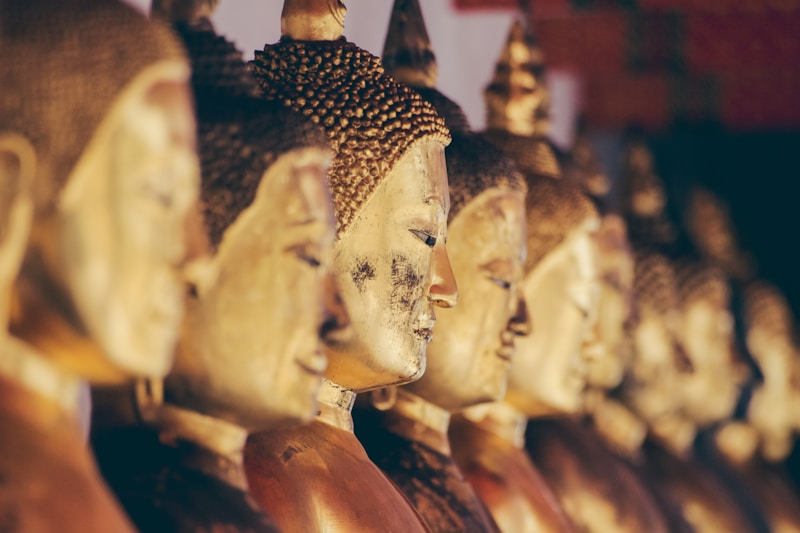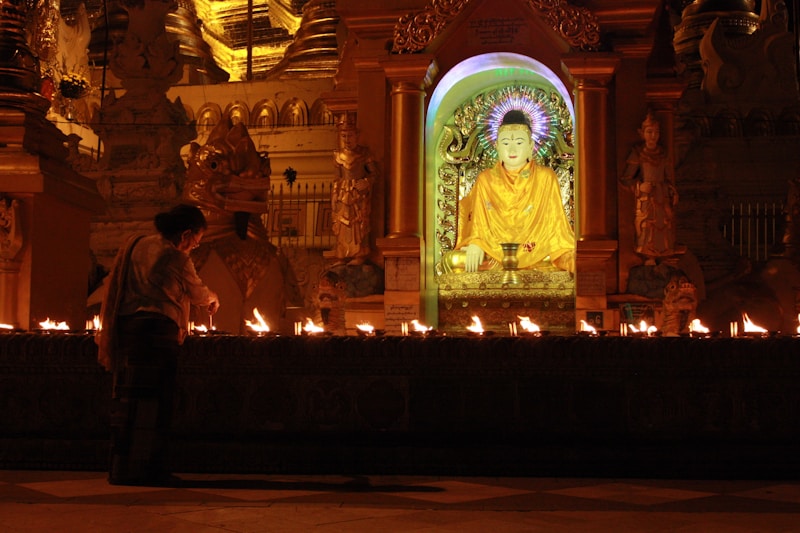9 Questions
What is the main difference between Theravada and Mahayana Buddhism?
What is the Noble Eightfold Path in Buddhism?
What is the Middle Way in Buddhism?
What are the Three Jewels in Buddhism?
What is the Buddhist theory of causality that explains the nature and relations of being, becoming, existence, and ultimate reality?
What is the significance of the Four Noble Truths in Buddhism?
What is the main difference between samatha and vipassana meditation?
What is the significance of the Bodhipakkhiyadhamma in Buddhism?
What is the significance of the Brahma-viharas in Buddhism?
Summary
Overview of Buddhism
-
Buddhism is a religion or philosophical tradition based on teachings attributed to the Buddha.
-
It originated in North India in the 5th century BCE and has spread throughout much of Asia via the Silk Road.
-
Buddhism is the world's fourth-largest religion, with over 520 million followers.
-
The Buddha's central teachings emphasize liberation from attachment and clinging to existence, marked by impermanence, dissatisfaction/suffering, and the absence of lasting essence.
-
Buddhist schools vary in their interpretation of the paths to liberation and the relative importance and 'canonicity' assigned to various Buddhist texts and their specific teachings and practices.
-
Two major branches of Buddhism are generally recognized by scholars: Theravāda and Mahāyāna.
-
The Theravada tradition emphasizes the attainment of nirvāṇa as a means of transcending the individual self and ending the cycle of death and rebirth, while the Mahayana tradition emphasizes the Bodhisattva-ideal, in which one works for the liberation of all beings.
-
Buddhism has a widespread following in Sri Lanka and Southeast Asia, namely Myanmar, Thailand, Laos, and Cambodia.
-
The Mahāyāna tradition is predominantly practiced in Nepal, Bhutan, China, Malaysia, Vietnam, Taiwan, Korea, and Japan.
-
Vajrayāna, a body of teachings attributed to Indian adepts, may be viewed as a separate branch or tradition within Mahāyāna.
-
The Buddhist canon is vast, with many different textual collections in different languages.
-
The Buddhist path emphasizes the Noble Eightfold Path, a training of the mind through observance of Buddhist ethics and meditation, as a means of achieving liberation from suffering.Overview of Buddhism
-
Buddhism has two main branches, Theravada and Mahayana, with many sub-schools and variations within each.
-
The Four Noble Truths are a core teaching of Buddhism, which state that suffering exists, suffering arises from craving and attachment, suffering can be overcome, and the path to overcoming suffering is the Eightfold Path.
-
The Eightfold Path consists of right view, right intention, right speech, right action, right livelihood, right effort, right mindfulness, and right concentration.
-
Nirvana is the state of liberation from the cycles of rebirth and suffering associated with saṃsāra, and is described in various ways, including as emptiness and nothingness.
-
Pratityasamutpada, or dependent arising, is the Buddhist theory of causality that explains the nature and relations of being, becoming, existence, and ultimate reality.
-
Anatta is the view that there is no unchanging, permanent self, soul, or essence in phenomena, and emptiness is the related concept that all phenomena lack inherent existence.
-
The Three Jewels are Buddha, Dharma, and Sangha, which all forms of Buddhism revere and take spiritual refuge in.
-
Buddha refers to someone who has become awake through their own efforts and insight, and Mahayana Buddhism reveres numerous Buddhas besides Shakyamuni.
-
Dharma refers to the Buddha's teaching, which is a pragmatic teaching to be put into practice and is the ultimate truth and reality about the universe.
-
Sangha refers to the monastic community of monks and nuns who follow Gautama Buddha's monastic discipline and preserve and pass down Buddha Dharma.
-
Mahayana Buddhism promotes several unique doctrines, including the unique interpretation of emptiness and dependent origination found in the Madhyamaka school, the main philosophical view of the Yogacara school, and the concept of Buddha-nature.
-
The Bodhipakkhiyadhamma are seven lists of qualities or factors that contribute to awakening, with the best-known list being the Noble Eightfold Path.
-
An important guiding principle of Buddhist practice is the Middle Way, which is a 'middle way' between the extremes of asceticism and hedonistic sense pleasures.Buddhist Path to Liberation
-
The path to liberation in the Early Buddhist Texts is presented as a "graduated talk" with a step-by-step training.
-
The Noble Eightfold Path is the most important and widely used presentation of the path to liberation in various Buddhist schools.
-
The Eightfold Path consists of eight interconnected factors or conditions that lead to the cessation of suffering.
-
The first step on the path is hearing the Buddha teach the Dharma, leading to acquiring confidence in the Buddha's teachings.
-
The first step in most Buddhist schools requires taking the "Three Refuges" as the foundation of one's religious practice.
-
Śīla or sīla, meaning "moral virtues", is the second group and an integral part of the Noble Eightfold Path.
-
Undertaking the Five Precepts is the most important system of morality in Buddhism, applicable to all Buddhists, and based on the principle of non-harming.
-
Vinaya is the specific code of conduct for a sangha of monks or nuns, which includes the Patimokkha, a set of 227 offences.
-
Restraint of the senses and renunciation are important practices taught by the Buddha, which weaken sense desires and give rise to inner peace and happiness.
-
Mindfulness and clear comprehension are central in Buddhism, with different practices and exercises for training mindfulness.
-
Meditation primarily refers to the attainment of samādhi and the practice of dhyāna, which aid in maintaining a calm mind.
-
The earliest evidence of meditation was found in the Rigveda, and while the meditative methodologies described in the Buddhist texts are some of the earliest, there is no scholarly agreement on their origin and source.An Overview of Buddhist Meditation, Ethics, Texts, and History
-
Buddhist meditation is generally divided into two main types: samatha (calming meditation) and vipassana (insight meditation).
-
The Brahma-viharas, or four immeasurables, are virtues or directions for meditation in Buddhist traditions that help a person be reborn in the heavenly realm.
-
Visualization practices, which involve mentally visualizing a Buddha image or deity, are popular in Vajrayana, Mahayana, and Theravada traditions.
-
Prajna or panna is wisdom or knowledge of the true nature of existence, while vipassana or vipasyana is insight cultivated through the four establishments of mindfulness.
-
Devotion is an important part of the practice of most Buddhists, and includes ritual prayer, prostration, offerings, pilgrimage, and chanting.
-
The Buddha's ethics strongly condemn the harming of all sentient beings, including animals, but early Buddhist texts depict the Buddha as allowing monastics to eat meat.
-
The earliest Buddhist texts were likely written down in Sri Lanka, about 400 years after the Buddha died, and many versions appeared thereafter claiming to be the words of the Buddha.
-
The Mahayana sutras are a genre of Buddhist scriptures that the Mahayana Buddhist tradition holds are original teachings of the Buddha.
-
Tantric Buddhism began to develop during the Gupta Empire, borrowing deities and material from other Indian religious traditions and featuring widespread use of mantras and meditation on the subtle body.
-
The roots of Buddhism lie in the religious thought of Iron Age India around the middle of the first millennium BCE, in a period of great intellectual ferment and socio-cultural change known as the "Second urbanisation".
-
The term Sramana refers to several Indian religious movements parallel to but separate from the historical Vedic religion, including Buddhism, Jainism, and others such as Ajivika.
-
Several Sramana movements are known to have existed in India before the 6th century BCE (pre-Buddha, pre-Mahavira), and these influenced both the astika and nastika traditions of Indian philosophy.
Description
How much do you know about Buddhism? Test your knowledge with our quiz! From the fundamentals of the Buddha's teachings to the different schools and branches of Buddhism, this quiz covers a wide range of topics related to Buddhism. Whether you're a beginner or a seasoned practitioner, this quiz will challenge your understanding of this ancient religion and philosophy. Answer questions on the Four Noble Truths, the Eightfold Path, the Bodhisattva-ideal, and more. Take the quiz and see how much you



